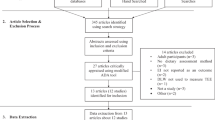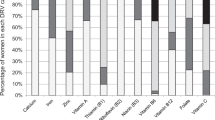Abstract
Objective: To compare iodine intakes estimated from weighed dietary records with iodine intakes obtained by direct analysis of duplicate diets in a group of vegans.
Design: Cross-sectional study.
Setting: London and the south-east of England.
Subjects: Thirty-three vegans consuming their habitual diet were recruited through the UK Vegan Society; 26 subjects (11 males, 15 females), age 21–84 y, completed the study.
Interventions: Iodine intakes were estimated from 4 day weighed dietary records and compared with iodine intakes obtained by direct analysis of concurrent 4 day duplicate diets.
Results: There was wide variation in iodine intakes. Mean daily iodine intake in males was significantly lower (P<0.05) when estimated from dietary records (42 µg) compared with that analysed from duplicate diets (137 µg). Conversely, in females the mean daily iodine intake from dietary records (1448 µg) was higher (P=0.43) than from duplicate diets (216 µg). Variation in iodine intakes determined by the two different methods may be attributed to the absence of iodine content of some foods, in particular foods suitable for vegan consumption, in food composition tables and the variability in iodine content of seaweed.
Conclusions: The use of current food tables to estimate iodine intake in vegans is limited. It is not always practical to determine iodine intake using the duplicate portion technique, therefore more reliable information on iodine content of foods, incorporating the variation within foods, is needed.
This is a preview of subscription content, access via your institution
Access options
Subscribe to this journal
Receive 12 print issues and online access
$259.00 per year
only $21.58 per issue
Buy this article
- Purchase on Springer Link
- Instant access to full article PDF
Prices may be subject to local taxes which are calculated during checkout
Similar content being viewed by others
References
Abdulla M, Andersson I, Asp N, Berthelsen K, Birkhed D, Dencker I, Johansson C, Jägerstad M, Kolar K, Nair BN, Nilsson-Ehle P, Norden A, Rassner S, Akesson B, Ockerman P . 1981 Nutrient intake and health status of vegans. Chemical analyses of diets using the duplicate portion sampling technique Am. J. Clin. Nutr. 34: 2464–2477
Abdulla M, Behbehani A, Dashti H . 1989 Dietary intake and bioavailability of trace elements Biol. Trace Elem. Res. 21: 173–178
Bingham SA . 1987 The dietary assessment of individuals; methods, accuracy, new techniques and recommendations Nutr. Abstr. Rev. 57: 705–742
Bingham SA, Cassidy A, Cole TJ, Welch A, Runswick SA, Black AE, Thurnham D, Bates C, Khaw KT, Key TJA, Day NE . 1995 Validation of weighed records and other methods of dietary assessment using the 24 h urine nitrogen technique and other biological markers Br. J. Nutr. 73: 531–550
Department of Health. 1991 Dietary Reference Values for Food Energy and Nutrients for the United Kingdom. Report on Health and Social Subjects no. 41 London: HMSO
Draper A, Lewis J, Malhotra N, Wheeler E . 1993 The energy and nutrient intakes of different types of vegetarian: a case for supplements? Br. J. Nutr. 69: 3–19
Gay C . 2000 Estimation of population distributions of habitual nutrient intake based on a short-run weighed food diary Br. J. Nutr. 83: 287–293
Goldberg GR, Black AE, Jebb SA, Cole TJ, Murgatroyd PR, Coward WA, Prentice AM . 1991 Critical evaluation of energy intake data using fundamental principles of energy physiology: 1. Derivation of cut-off limits to identify under-reporting Eur. J. Clin. Nutr. 45: 569–581
Gregory J, Foster K, Tyler H, Wiseman M . 1990 The Dietary and Nutritional Survey of British Adults London: HMSO
Isaksson B . 1993 A critical evaluation of the duplicate-portion technique in dietary surveys Eur. J. Clin. Nutr. 47: 457–460
James WPT, Bingham SA, Cole TJ . 1981 Epidemiological assessment of dietary intake Nutr. Cancer 2: 203–212
Katamine S, Mamiya Y, Sekimoto K, Hoshino N, Totsuka K, Naruse U, Watabe A, Sugiyama R, Suzuki M . 1986 Iodine content of various meals currently consumed by urban Japanese J. Nutr. Sci. Vitaminol. 32: 487–495
Lee SM, Lewis J, Buss DH, Holcombe GD, Lawrance PR . 1994 Iodine in British foods and diets Br. J. Nutr. 72: 435–446
Lightowler HJ, Davies GJ . 1996 Sources of iodine in the vegan diet Proc. Nutr. Soc. 55: 33A
Lightowler HJ, Davies GJ . 1998 Iodine intake and iodine deficiency in vegans as assessed by the duplicate-portion technique and urinary iodine excretion Br. J. Nutr. 80: 529–535
Ministry of Agriculture, Fisheries and Food. 1997 Dietary intake of iodine and fatty acids Food Surveillance Information Sheet 127: 1–10
Moxon RED, Dixon EJ . 1980 Semi-automatic method for the determination of total iodine in food Analyst 105: 344–352
Nelson M, Phillips DIW, Morris JA, Wood TJ . 1987 Urinary iodine excretion correlates with milk iodine content in seven British towns J. Epidemiol. Community Health 42: 72–75
Petersen BJ, Barraj LM . 1996 Assessing the intake of contaminants and nutrients: an overview of methods J. Food Comp. Anal. 9: 243–254
Rauma A-L, Törmälä, Nenonen M, Hänninen O . 1994 Iodine status in vegans consuming a living food diet Nutr. Res. 14: 1789–1795
Remer T, Neubert A, Manz F . 1999 Increased risk of iodine deficiency with vegetarian nutrition Br. J. Nutr. 81: 45–49
Schofield WN, Schofield C, James WPT . 1985 Basal metabolic rate—review and prediction, together with an annotated bibliography of source material Hum. Nutr.: Clin. Nutr. 39C: (Supp1): 1–96
Stockley L . 1985 Changes in habitual food intake during weighed inventory surveys and duplication diet collections. A short review Ecol. Food. Nutr. 17: 263–269
West CE, van Staveren WA . 1995 Food consumption, nutrient intake, and the use of food composition tables In Design Concepts in Nutritional Epidemiology ed. BM Margetts & M Nelson, pp 101–109 Oxford: Oxford University Press
Acknowledgements
The authors thank the subjects for their participation and Dr A Long for his support.
Author information
Authors and Affiliations
Corresponding author
Rights and permissions
About this article
Cite this article
Lightowler, H., Davies, G. Assessment of iodine intake in vegans: weighed dietary record vs duplicate portion technique. Eur J Clin Nutr 56, 765–770 (2002). https://doi.org/10.1038/sj.ejcn.1601392
Received:
Revised:
Accepted:
Published:
Issue Date:
DOI: https://doi.org/10.1038/sj.ejcn.1601392
Keywords
This article is cited by
-
Prevalence of iodine deficiency among vegan compared to vegetarian and omnivore children in the Czech Republic: cross-sectional study
European Journal of Clinical Nutrition (2023)
-
Knowledge and awareness about and use of iodised salt among students in Germany and Greece
BMC Public Health (2022)
-
Algae as nutritional and functional food sources: revisiting our understanding
Journal of Applied Phycology (2017)
-
Associations between estimated acrylamide intakes, and hemoglobin AA adducts in a sample from the Malmö Diet and Cancer cohort
European Journal of Clinical Nutrition (2008)



